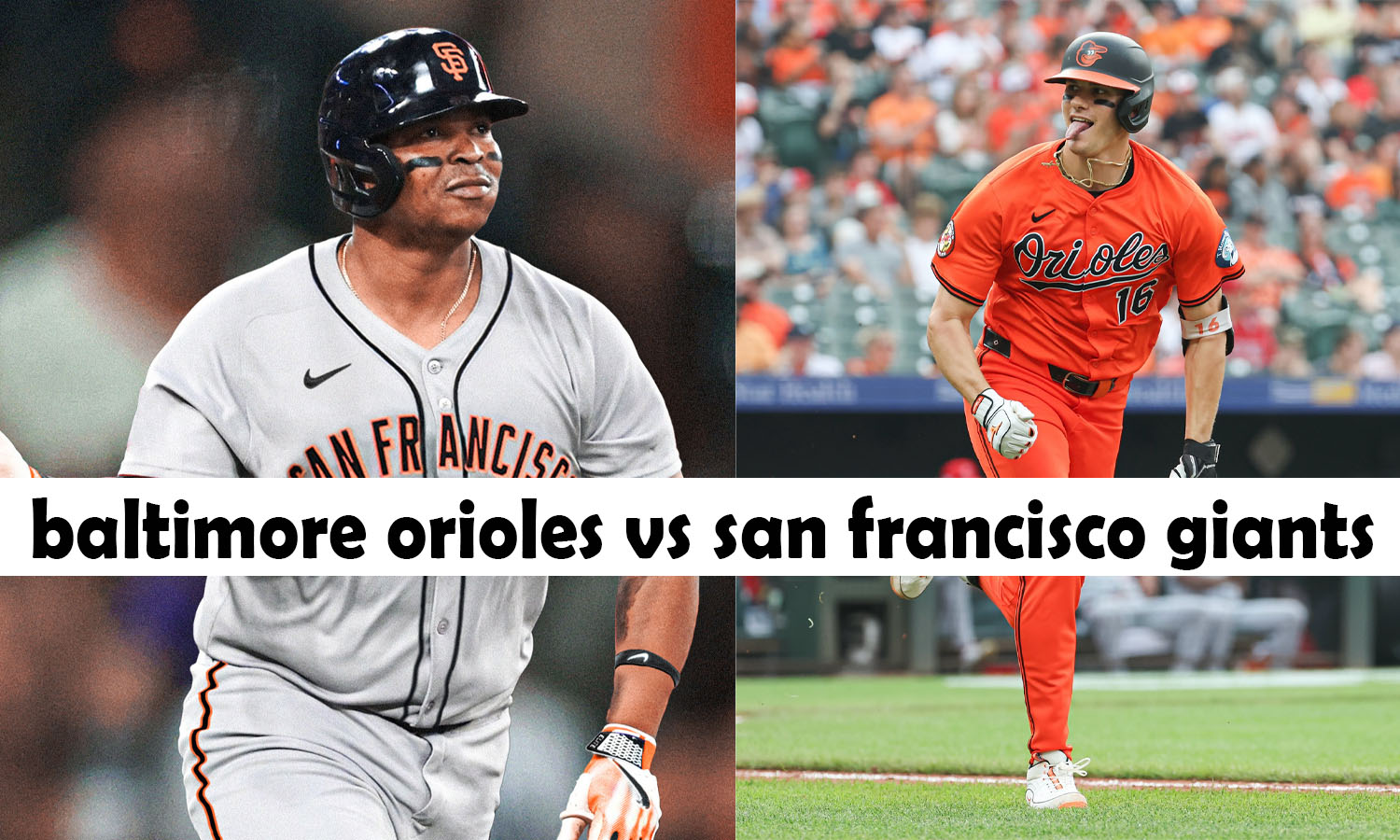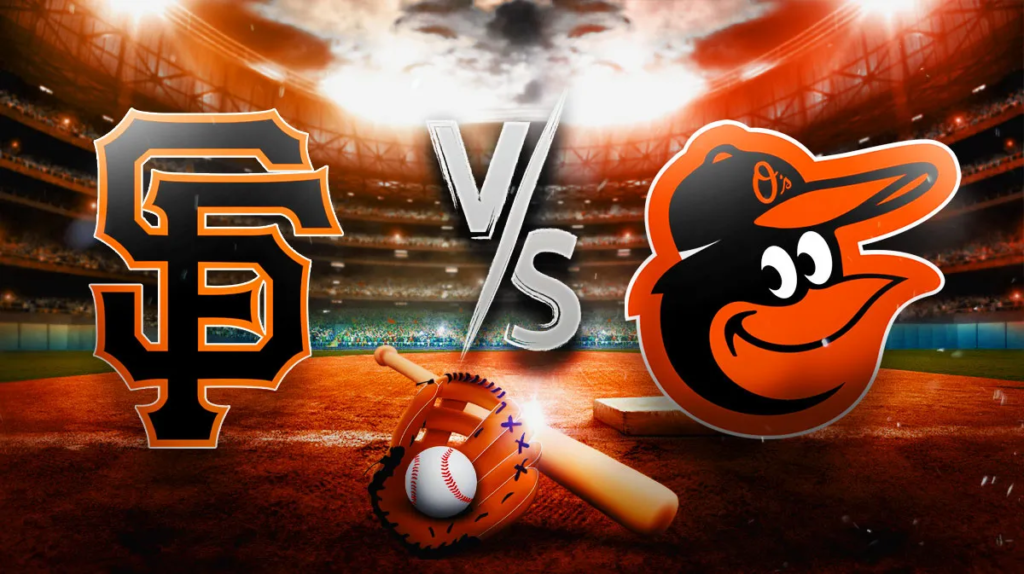Sports
A Deep Dive into baltimore orioles vs san francisco giants match player stats

When two iconic franchises like the Baltimore Orioles and the San Francisco Giants clash on the baseball diamond, it’s more than just a game; it’s a confluence of history, strategy, and individual brilliance. While these teams reside in different leagues, their interleague matchups are always a treat for fans, offering unique opportunities to compare and contrast playing styles and individual talents. Looking beyond just who won or lost, diving into the player statistics reveals the intricate details that shape these contests.
A Glimpse Through Time: The Head-to-Head Record
The Baltimore Orioles and San Francisco Giants share a surprisingly balanced all-time head-to-head record, standing at 12-12. This even split, especially considering their limited opportunities to play each other outside of interleague play and the World Series (which they have never met in), speaks volumes about the competitive nature of their matchups. It suggests that when these two teams face off, it’s often a tight contest where individual player performances can swing the momentum significantly.
Their interactions have spanned decades, and while the rosters have changed countless times, the underlying competitiveness remains. These games aren’t part of a heated divisional rivalry, but rather special occasions that capture the essence of baseball’s interleague charm, allowing fans to witness different styles of play from across the country.
Recent Encounters: A Focus on the September 2024 Series
To truly understand player statistics in action, it’s invaluable to pinpoint a recent series. The matchups in September 2024 offer a fantastic snapshot of contemporary player performance. Specifically, the game on September 17, 2024, where the San Francisco Giants dominated the Baltimore Orioles with a 10-0 victory, provides a rich source of individual statistics that illustrate a complete team effort on one side and a challenging night for the other.
San Francisco Giants: A Masterclass in Dominance

The Giants’ offensive and pitching prowess was on full display in that 10-0 shutout.
Pitching Excellence:
- Blake Snell (P): As the winning pitcher, Snell delivered a masterful performance, going 6.0 innings, allowing just 2 walks, and striking out an impressive 12 batters. His 98 pitches were efficiently used to stifle the Orioles’ lineup, demonstrating his ability to command the strike zone and overpower hitters. A strong performance from a starting pitcher sets the tone for the entire game, and Snell certainly did that, picking up his fourth win of the season.
Offensive Firepower:
- Grant McCray (CF): McCray was a spark plug at the top of the lineup, going 2-for-2 with 3 runs scored and 2 walks. His ability to get on base and then convert those opportunities into runs was crucial in building the Giants’ lead. This kind of offensive production from a leadoff hitter is a nightmare for opposing pitchers.
- Mike Yastrzemski (RF): Yastrzemski had a fantastic night at the plate, going 2-for-4 with 2 runs, 2 RBIs, and a towering home run. His power and timely hitting were instrumental in driving in runs and extending the Giants’ advantage. A home run is often a momentum shifter, and Yastrzemski’s blast certainly contributed to the Giants’ runaway victory.
- LaMonte Wade (1B): Wade contributed with a 1-for-5 performance, but more importantly, he drove in 2 RBIs. Even without a multitude of hits, his ability to deliver in run-scoring situations highlighted the Giants’ effective situational hitting.
- Heliot Ramos (LF): Ramos also chipped in with a 1-for-5 outing and an RBI, further demonstrating the widespread offensive contributions throughout the Giants’ lineup.
- Michael Conforto (DH): Conforto, like Ramos, went 1-for-5 with 2 RBIs, showcasing the depth of the Giants’ batting order and their collective ability to convert opportunities into runs.
- Patrick Bailey (C): Bailey added a hit, going 1-for-5, ensuring that nearly every batter in the Giants’ starting nine made a contribution.
- Casey Schmitt (3B): Schmitt’s 1-for-2 performance included 2 RBIs, making his plate appearances highly impactful and efficient in driving in runs.
This collective effort from the Giants’ lineup, combined with Snell’s dominant pitching, painted a clear picture of their strong team performance on that particular night.
Baltimore Orioles: A Challenging Outing

For the Orioles, the September 17th game was a tough one, both offensively and on the mound.
Offensive Struggles:
- Adley Rutschman (C): As a key offensive threat, Rutschman went 0-for-4, a rare quiet night for the talented catcher. His inability to get on base impacted the Orioles’ ability to generate offense.
- Gunnar Henderson (SS): Henderson also went 0-for-4, another surprising stat for one of the Orioles’ rising stars. When key players struggle, the entire offense can suffer.
- Anthony Santander (RF): Santander mirrored his teammates with an 0-for-4 performance, indicating a collective struggle against Blake Snell’s pitching.
- Enrique Jimenez (DH): Jimenez went 0-for-2 before being replaced.
- Colton Cowser (PH-LF): Cowser was one of the few bright spots, managing a hit in his only at-bat (1-for-1) as a pinch-hitter.
- Heston Kjerstad (PH-DH): Kjerstad also showed some fight, going 2-for-2 off the bench, demonstrating his potential to spark the offense.
- Estrada Rivera (3B): Rivera managed a hit, going 1-for-2.
- Ryan O’Hearn (PH-1B): O’Hearn also contributed a hit, going 1-for-2.
- Cedric Mullins (CF): Mullins went 0-for-3.
- Connor Mayo (1B-3B): Mayo went 0-for-2.
- Jackson Holliday (PH-2B): Holliday went 0-for-1.
Pitching Challenges:
- Albert Suarez (P): Suarez was the losing pitcher, his 8-6 record reflecting the challenges he faced on the mound against a potent Giants’ lineup. While the box score doesn’t detail his specific innings or runs allowed, the 10-0 final score indicates that the pitching staff, collectively, had a difficult time containing the Giants’ offense.
The statistical breakdown of this game clearly illustrates how a dominant pitching performance combined with timely and widespread offensive contributions can lead to a lopsided victory. For the Orioles, it was a night where their typically strong hitters couldn’t break through, and their pitching struggled to contain the Giants’ bats.
Notable Players Who’ve Crossed the Divide
An interesting facet of interleague play and the long history of Major League Baseball is the number of players who have worn both the orange and black of the Orioles and the black and orange of the Giants. While they might not be considered “rivals” in the traditional sense, these players add a layer of shared history to their occasional matchups.
One of the most prominent names is Will Clark. Known for his smooth left-handed swing and intense demeanor, Clark spent the majority of his illustrious career with the San Francisco Giants, becoming a fan favorite and a true face of the franchise. Later in his career, he had a stint with the Baltimore Orioles, offering a unique connection between the two clubs. His presence on both rosters highlights the transient nature of professional baseball careers and the way players contribute to the rich tapestries of multiple team histories.
Another Hall of Famer who played for both franchises is Hoyt Wilhelm. A pioneer of the knuckleball, Wilhelm’s career spanned decades, and he pitched effectively for both the Orioles and the Giants, among other teams. His enduring legacy as a reliever and the uniqueness of his pitching style make him a memorable link between these two storied organizations.
These players, and many others like them, represent the shared heritage of baseball, where individual careers often weave through various team histories, creating a subtle, yet significant, connection when those teams eventually meet.
The Nuances of Player Statistics: Beyond the Box Score
While a single game’s box score gives us a snapshot, true player statistics analysis goes deeper. It involves understanding the context of those numbers, the situations in which they were achieved, and how they contribute to a player’s overall season and career.
- Batting Average (AVG): While a fundamental stat, a player’s batting average in head-to-head matchups can sometimes be misleading due to small sample sizes. However, when looking at a player’s overall season average, it gives an indication of their consistency at the plate.
- On-Base Percentage (OBP): This stat is crucial for understanding how often a player gets on base, whether by hit, walk, or hit-by-pitch. A high OBP indicates a player who consistently creates opportunities for the team to score.
- Slugging Percentage (SLG): Slugging percentage measures a hitter’s power, reflecting their ability to hit for extra bases (doubles, triples, and home runs).
- On-Base Plus Slugging (OPS): OPS combines OBP and SLG, providing a comprehensive measure of a player’s offensive production. It’s often considered one of the best single statistics for evaluating a hitter.
- Runs Batted In (RBI): This stat shows a player’s ability to drive in runs, often reflecting their performance in clutch situations with runners on base.
- Home Runs (HR): The ultimate display of power, home runs are often the most exciting plays in baseball and can drastically change the course of a game.
- Strikeouts (SO) (Pitching): For pitchers, strikeouts are a direct measure of their ability to overpower hitters and prevent them from making contact. Blake Snell’s 12 strikeouts in the September 17th game are a prime example of a dominant strikeout performance.
- Walks (BB) (Pitching): While not as flashy as strikeouts, walks are critical for pitchers. Too many walks can lead to baserunners and put a pitcher in difficult situations, potentially leading to runs.
- Innings Pitched (IP): This stat measures how long a pitcher stays in the game. A high innings pitched total indicates durability and efficiency.
- Earned Run Average (ERA): ERA is perhaps the most well-known pitching statistic, representing the average number of earned runs a pitcher allows per nine innings. A low ERA signifies a highly effective pitcher.
When analyzing the Orioles and Giants, we consider these metrics for their individual players, understanding that a strong collective performance across these categories is often the hallmark of a winning team.
The Unseen Influences: Beyond the Numbers
While player stats are a quantitative representation of performance, they don’t always tell the whole story. Factors such as:
- Momentum: The psychological aspect of a game can influence individual and team performance. A big hit or a clutch strikeout can shift momentum dramatically.
- Home vs. Away Advantage: Playing at home, with a familiar crowd and environment, can often provide a subtle edge.
- Fatigue and Travel: Interleague play often involves cross-country travel, which can impact player performance.
- Managerial Decisions: Lineup changes, pitching matchups, and in-game strategies by the managers can significantly affect how individual player stats unfold.
- Injuries: Key player injuries can alter the dynamics of a lineup or pitching staff, impacting team performance and individual statistics.
These qualitative factors interact with the raw numbers to create the full narrative of a baseball game.
Looking Ahead: The Evolution of Player Performance
As baseball continues to evolve, so too do the metrics used to evaluate player performance. Advanced analytics, such as WAR (Wins Above Replacement), FIP (Fielding Independent Pitching), and wRC+ (Weighted Runs Created Plus), offer even deeper insights into a player’s true value and contribution. While traditional stats remain popular and easy to understand, these advanced metrics provide a more nuanced picture, often revealing hidden gems and unsung heroes.
The Baltimore Orioles and San Francisco Giants, like all MLB teams, utilize these advanced statistics to scout players, make strategic decisions, and evaluate their rosters. This ongoing evolution of statistical analysis means that our understanding of “player stats” is constantly expanding, providing fans with richer ways to appreciate the game.
In conclusion, the encounters between the Baltimore Orioles and the San Francisco Giants, while infrequent, are always intriguing. By delving into the player statistics from these matchups, we gain a clearer understanding of the individual contributions that shape the outcomes. From dominant pitching performances to clutch hitting, every number tells a story, contributing to the rich tapestry of baseball’s interleague narrative.
Frequently Asked Questions about Orioles vs. Giants Player Stats
1. How often do the Baltimore Orioles and San Francisco Giants play each other? As teams from different leagues (American League and National League, respectively), they only play each other during interleague play in the regular season. This typically means a single series, often just three games, per season or every other season, depending on the MLB schedule rotation.
2. What is the all-time head-to-head record between the Orioles and Giants? The all-time head-to-head record between the San Francisco Giants and the Baltimore Orioles is an even 12-12.
3. Have the Orioles and Giants ever met in the World Series? No, the Baltimore Orioles and San Francisco Giants have never met in the World Series.
4. Which Giants pitcher had a standout performance against the Orioles in September 2024? Blake Snell, for the San Francisco Giants, had a dominant outing against the Orioles on September 17, 2024, pitching 6.0 shutout innings with 12 strikeouts.
5. Which Orioles hitters struggled in the September 17, 2024, game against the Giants? Key Orioles hitters like Adley Rutschman, Gunnar Henderson, and Anthony Santander all went hitless in the September 17, 2024, game.
6. Are there any notable players who have played for both the Orioles and the Giants? Yes, two prominent players who have played for both franchises are Will Clark, a beloved first baseman for the Giants who later played for the Orioles, and Hall of Fame knuckleballer Hoyt Wilhelm.
7. What are some key offensive player statistics to look at in a baseball game? Key offensive stats include Batting Average (AVG), On-Base Percentage (OBP), Slugging Percentage (SLG), On-Base Plus Slugging (OPS), Runs Batted In (RBI), and Home Runs (HR).
8. What are some important pitching player statistics to analyze? Important pitching stats include Earned Run Average (ERA), Strikeouts (SO), Walks (BB), and Innings Pitched (IP).
9. Why is interleague play important for analyzing player stats? Interleague play provides unique opportunities to see how players from different leagues perform against unfamiliar opponents and pitching staffs, offering fresh insights into their versatility and adaptability.
10. Do advanced analytics play a role in evaluating player performance in these matchups? Absolutely. While traditional stats are valuable, advanced metrics like WAR (Wins Above Replacement) and FIP (Fielding Independent Pitching) offer deeper, more nuanced insights into a player’s overall contribution and effectiveness, both in specific matchups and over the course of a season.
Click for more amazing info. News MM

-

 Celebrity4 months ago
Celebrity4 months agoIndia Rose Brittenham: All You Need to Know About Heather Thomas’ Daughter
-

 Celebrity4 months ago
Celebrity4 months agoMargot Rooker: All You Need to Know About Michael Rooker’s Wife
-

 Celebrity4 months ago
Celebrity4 months agoNadia Farmiga? All You Need to Know About Taissa Farmiga’s Sister
-

 Celebrity3 months ago
Celebrity3 months agoVerna Aho? All You Need to Know About Lauri Markkanen’s Wife
-

 Celebrity4 months ago
Celebrity4 months agoRobert Noah? All You Need to Know About Trevor Noah’s Father
-

 Celebrity3 months ago
Celebrity3 months agoJackie Witte? All You Need to Know About Paul Newman’s First Wife
-

 Celebrity3 months ago
Celebrity3 months agoWho Is Itchko Ezratti’s Wife? Anna Ezratti Supporting Her Husband’s Legacy
-

 Celebrity3 months ago
Celebrity3 months agoCheryl Pistono? All You Need to Know About Kareem Abdul-Jabbar’s Ex-Girlfriend












